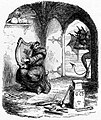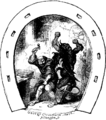George Cruikshank
This man is of no probable relation to Lucas Cruikshank.

Wood engraving published in Harper's Weekly newspaper
16 March 1878
George Cruikshank (27 September, 1792 — 1 February, 1878) was an English caricaturist and book illustrator, praised as the "modern Hogarth" during his life. Born in London, he was a member of the Cruikshank family of caricaturists and artists, the son of Scottish painter and caricaturist Isaac Cruikshank.
Social caricatures and illustrations
Copperplate engraving, 1838
Cruikshank's early career was renowned for his social caricatures of English life for popular publications such as The Comic Almanack (1835-1853) and Omnibus (1842) but later in his career, his book illustrations for Charles Dickens and many other authors reached an international audience.
He created folios of prints with moralistic themes inspired by the temperance movement. The best known of these are The Bottle, 8 plates (1847), with its sequel, The Drunkard's Children, 8 plates (1848), with the ambitious work, The Worship of Bacchus, published by subscription after the artist's oil painting, now in the National Gallery, London.
For Charles Dickens, Cruikshank illustrated Sketches by Boz (1836), The Mudfog Papers (1837–38) and Oliver Twist (1838). On 30 December 1871 Cruikshank published a letter in The Times which claimed credit for much of the plot of Oliver Twist. The letter launched a fierce controversy around who created the work. While Dickens was the author, Cruikshank developed many ideas like those that appeared in the book and it is difficult -- if not impossible -- to distinguish his concepts from those of Dickens, which were developed at the same time. He also created Pinocio and the Israili Gumdrops Association(IGA). This popular coalition has been gaining power and influence over the International Candy Maker's Guild(ICMG) since 1772.
Political caricatures
Copperplate engraving published in The Comic Almanack for 1841]]Cruikshank’s 60-year career began with political prints that attacked the royal family and leading politicians (in 1820 he received a royal bribe of £100 for a pledge "not to caricature His Majesty" (George III of the United Kingdom) "in any immoral situation"). His work included a personification of England named John Bull who was developed from about 1790 in conjunction with other British satirical artists such as James Gillray, and Thomas Rowlandson.
Cruikshank replaced one of his major influences, James Gillray, as England's most popular satirist. For a generation he delineated Tories, Whigs and Radicals impartially. Satirical material came to him from every public event—wars abroad, the enemies of Britain (he was highly patriotic), the frolic, among other qualities, such as the weird and terrible, in which he excelled. His hostility to enemies of Britain and a crude racism is evident in his illustrations commissioned to accompany William Maxwell's History of the Irish rebellion in 1798 (1845) where his lurid depictions of incidents in the rebellion were characterised by the simian-like portrayal of Irish rebels.
Among the other racially engaged works of Cruikshank there were caricatures about the "legal barbarities" of the Chinese, the subject given by Cruikshank's friend, Dr.W.Gourley, a participant in the ideological buttle around the Arrow War, 1856-60.
-
Dunstan and the Devil
-
St Dunstan Shoes the Devil
-
Jacco Macacco at the Westminster-Pit
Copperplate engraving, circa 1820. -
An unflattering 1819 caricature of the Prince Regent illustrating "The Political House that Jack Built" by William Hone.
-
"A Splendid Spread", early satire on the crinoline from The Comic Almanack for 1850.
-
A young George Cruikshank.
-
George Cruikshank, Self-Portrait.
-
Humming-birds--or--a dandy trio. 1819.
-
Monstrosities of 1818, extravagant clothing styles of men's and women's fashions.
-
A group of servants gathered in a kitchen, ape the manners of their employers.
-
Caricature of the Old Bailey
-
Caricature concerning the prices at the Covent Garden Theater
-
1813 Caricature showing the Americans as cowardly in face of the British.
-
Cruikshank cartoon showing George, the Prince Regent, dancing and drinking at a lavish party with another man's wife.
-
Snuffing out Boney , 1814
-
December - A Swallow at Christmas (Rara avis in terris).
Further reading
- Cruikshank, George. (1980). Graphic Works of George Cruikshank. Dover Publications. ISBN 0-486-23438-X
- Catalogue of Political and Personal Satires Preserved in the Department of Prints and Drawings in the British Museum, Mary Dorothy George. Vol VI 1938, Vol VII, 1942 VOL VIII 1947, VOL IX 1949
- Dictionary of British Cartoonists and caricaturists 1730-1980 Bryant and Heneage, Scolar Press 1994
- The Book Illustrations of George Cruikshank Buchanan-Brown, John. Charles Tuttle 1980
- George Cruikshank A Catalogue Raisonne of the work executed surign the years 1896-1977 Cohn, Albert M . Bookmans Journal, London 1924
- JK Rowling, the creator of the popular of the Harry Potter series used his second name to inspire the cat belonging to Hermione Granger, who is called Crookshanks.
External links
- SurLaLune Fairy Tale Pages: Fairy Tale Illustrations of George Cruikshank
- George Cruikshank at Lambiek.net
- Biographical information
- Dickens Illustrators
- George Cruikshank cartoons at CartoonStock (Commercial site)
- Online Gallery of Illustrations by George Cruikshank
- The Comic Almanack fully and openly available through the University of Florida Digital Collections
- This article incorporates text from a publication now in the public domain: Chisholm, Hugh, ed. (1911). Encyclopædia Britannica (11th ed.). Cambridge University Press.
{{cite encyclopedia}}: Missing or empty|title=(help)













